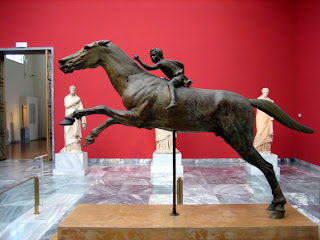EGYPTIAN ART – NEW KINGDOM
Ancient Egypt was a stable kingdom, in which several periods of relative instability came between it. New Kingdom of Ancient Egypt came after the disunity of the civilization called the Second Intermediate Period and followed by the Third Intermediate Period where the central government of the civilization was dissolved. New Kingdom was the most thriving time of Egypt, dated between 1570 – 1069 BCE. This kingdom, covering the 18th, 19th and 20th Dynasties of Egypt, is the era that was completely documented and gives a great understanding of Ancient Egyptian history. It was during this period that the rulers being called ‘pharaoh’ and a few well-known New Kingdom’s pharaohs were Hatshepsut, Akhenaten, Tutankhamun, Ramesses II and Ramesses III.
Golden Death Mask of Tutankhamun
Valley of the Kings, Egypt
1332 – 1323 BCE (sovereign)
Tutankhamun is the most popular pharaoh in these modern days. He is also known as Tutankhamen and ‘King Tut’. He was born in 1345 BCE during the reign of his father, Pharaoh Amenhotep IV and died at the age of 18 in 1327 BCE. Tutankhamun succeeded the throne when his father died in 1336 BCE. He was only 9 years old when he became the ruler of Egypt during the 18th Dynasty of the New Kingdom (c. 1332–1323 BCE). In 1922 CE, a British archaeologist found Tutankhamun’s tomb in the Valley of the Kings, which caused Tutankhamun to become a celebrity pharaoh he is today.
There were three coffins that hold the body of the king. Those three coffins were found in a sarcophagus, a box-like container. The outer two coffins were made of wood and covered in many semiprecious stones such as lapis lazuli and turquoise. However, the most inner coffin, the one that contains the body of Tutankhamun, was made of solid gold with inlay of enamel and many semiprecious stones. The death mask, on the other hand, was put directly on the mummy’s shoulders inside the innermost gold coffin. It was made up of two sheets of gold that were hammered together and weigh around 10kg. Tutankhamen is depicted wearing the striped nemes headdress which is the striped head-cloth typically worn by pharaohs. He also wears a false beard that further connects him to the image of a god as with the inner coffin. He wears a broad collar, which ends in terminals shaped as falcon heads. The back of the mask is covered with Spell 151b from the Book of the Dead, which the Egyptians used as a road map for the afterlife. This particular spell protects the various limbs of Tutankhamun as he moves into the underworld.




Comments
Post a Comment